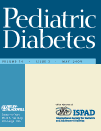Long-chain polyunsaturated fatty acids in a diabetic teenager during and after nine repeated episodes of diabetic ketoacidosis
Abstract
Abstract: Type 1 diabetes is often accompanied with acute hypoinsulinemia that may theoretically inhibit the conversion of essential fatty acids to their longer-chain metabolites. Previously, we found significant reduction in plasma arachidonic (C20:4n-6) and docosahexaenoic (C22:6n-3) acid values in a group of diabetic children during diabetic ketoacidosis. Here we report data on the changes of fatty acids in plasma phospholipids in a diabetic teenager during and after nine subsequent episodes of diabetic ketoacidosis (DKA). Plasma phospholipid linoleic acid (C18:2n-6) values significantly decreased [23.05 (1.05) versus 19.22 (3.22), % w/w, median (IQR), p < 0.01], while values of dihomo-gamma-linolenic acid (C20:3n-6) and docosatetraenoic acid (C22:4n-6) significantly increased [1.72 (0.44) versus 1.80 (0.63) and 0.40 (0.01) versus 0.45 (0.07), respectively, p < 0.05]. Values of alpha-linolenic acid (C18:3n-3) did not change, while values of docosahexaenoic acid were significantly higher after than during the ketoacidosis [1.57 (0.67) versus 1.87 (0.32), p < 0.05). These data obtained in the same patient during repeated episodes of diabetic ketoacidosis support the concept that hypoinsulinemia plays an important role in disturbances of essential fatty acid metabolism in diabetes.




